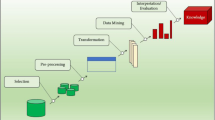Abstract
Lung cancer is rated with the highest incidence and mortality every year compared with other forms of cancer, therefore early detection and diagnosis is essential. Artificial Neural Networks (ANNs) are “artificial intelligence” software which have been used to assess a few prognostic situations. In this study, a database containing 193 patients from Diagnostic and Monitoring of Tuberculosis and Illness of Lungs Ward in Kuyavia and Pomerania Centre of the Pulmonology (Bydgoszcz, Poland) was analysed using ANNs. Each patient was described using 48 factors (i.e. age, sex, data of patient history, results from medical examinations etc.) and, as an output value, the expected presence of lung cancer was established. All 48 features were retrospectively collected and the database was divided into a training set (n=97), testing set (n=48) and a validating set (n=48). The best prediction score of the ANN model (MLP 48-9-2) was above 0.99 of the area under a receiver operator characteristic (ROC) curve. The ANNs were able to correctly classify 47 out of 48 test cases. These data suggest that Artificial Neural Networks can be used in prognosis of lung cancer and could help the physician in diagnosis of patients with the suspicion of lung cancer.
Similar content being viewed by others
References
Jemal A., Siegel R., Xu J., Ward E., Cancer Statistics 2010, Ca. Cancer. J. Clin., 2010, 60, 277–300
Siegel R., Naishadham D., Jemal A., Cancer statistics, 2012, CA Cancer J Clin., 2012 62, 10–29
Szczuka I., Roszkowski-Ślisz K., Lung cancer in Poland in 1970–2004, Pneumonol. Alergol. Pol., 2008, 76, 19–28
Ahmed K., Emran A.A., Jesmin T., Early detection of lung cancer risk using data mining, Asian Pac. J.Cancer Prev., 2013, 14, 595–598
Flores J.M., Herrera E., Leal G, Artificial Neural Network-Based Serum Biomarkers Analysis Improves Sensitivity in the Diagnosis of Lung Cancer, IFMBE Proceedings 2013, 33, 882–885
Bishop C.M., Neural networks for pattern recognition, New York, NY: Oxford University Press 1995.
Dayhoff J.E., DeLeo J.M., Artificial neural networks: opening the black box, Cancer, 2001, 91, 1615–1635
Cross S.S., Harrison F.H., Kennedy R.L., Introduction to neural networks. Lancet, 1995, 346, 1075–1079
Baxt W.G., Application of artificial neural networks to clinical medicine, Lancet, 1995, 346, 1135–1138
Amato F., López A., Peña-Méndez E. M., Artificial neural networks in medical diagnosis, J. Appl. Biomed., 2013, 11, 47–58
Alkim E., Gürbüz E., Kiliç E., A fast and adaptiveautomated disease diagnosis method with an innovative neural network model, Neur. Networks, 2012, 33, 88–96
Atkov O., Gorokhova S., Sboev A., Coronary heart disease diagnosis by artificial neural networks including genetic polymorphisms and clinical parameters, J. Cardiol., 2012, 59, 190–194
Buciński A., Bączek T., Kaliszan R., Nasal A., Krysiński J., Załuski J., Artificial Neural Network Analysis of Patient and Treatment Variables as a Prognostic Tool in Breast Cancer after Mastectomy, Adv. Clin. Exp. Med., 2005, 14, 973–979
Patel J.L., Goyal R.K., Application of artificial neural networks in medicinal science, Curr. Clin. Pharmacol., 2007, 2, 217–226
Atkov O., Gorokhova S., Sboev A., Coronary heart disease diagnosis by artificial neural networks including genetic polymorphisms and clinical parameters, J. Cardiol., 2012, 59, 190–194
Uğuz H., A biomedical system based on artificial neural network and principal component analysis for diagnosis of the heart valve diseases., J. Med. Syst., 2012, 36, 61–72
Esteva H., Bellotti M., Marchevsky A.M., Neural networks for the estimation of prognosis in lung cancer, In: Naguib R.N., Sherbet G.V. eds. Artificial neural networks in cancer diagnosis, prognosis and patient management. Boca Raton: CRC Press, 2001: 29–37
Bucinski A., Marszall M.P., Krysinski J., Lemieszek A., Zaluski A., Contribution of artificial intelligence to the knowledge of prognostic factors in Hodgkin’s lymphoma, Eur. J. Cancer Prev., 2010, 19, 308–312
Cinar M., Engin M., Egin E. Z., Atesci Y. Z., Early prostate cancer diagnosis by using artificial neural networks and support vector machines, Expert Systems with Applications, 2009, 36, 6357–6361
Marszałł M.P., Krysiński J., Sroka W. D., Nyczak Z., Stefanowicz M., Waśniewski T., Romaszko J., Buciński A. ANN as a prognostic tool after treatment of non-seminoma testicular cancer, Central Eur. J. Med. 2012, 7, 672–679
Bączek T., Buciński A., Ivanov A.R., Kaliszan R., Artificial neural network analysis for evaluation of peptide MS/MS spectra in proteomics, Anal. Chem., 2004, 76, 1726–1732
Koba M., Application of artificial neural networks for the prediction of antitumor activity of a series of acridinone derivatives, Med. Chem., 2012, 8, 309–319
Luenberger D.G., Ye Y., Linear and nonlinear programming, International Series in Operations Research & Management Science 116 (Third ed.), New York, Springer, 2008, pp. xiv+546
Knyazev, A.V., Lashuk I., Steepest Descent and Conjugate Gradient Methods with Variable Preconditioning, SIAM J. Matrix Anal. A, 2008, 29, 1267–1280
Chen T.M., Kuschner W.G., Non-tobacco related lung carcinogens. Lung cancer principle and practice, In: Harvey P. et al, editors. 3rd ed, Lippincot Williams and Wilkins: 2005. p. 61–73
Bij S., Hendrik Koffijberg H., Lenters V., Lung cancer risk at low cumulative asbestos exposure: meta-regression of the exposure-response relationship, Cancer Cause. Control, 2013, 24, 1–12
Alberg A.J., Samet J.M., Epidemiology of lung cancer, Chest, 2003, 123, 21S–49S
Shopland D., Tobacco use and its contribution to early cancer mortality with a special emphasis on cigarette smoking, Environ. Health. Prospect., 1995, 103, 131–142
Doll R., Peto R., Boreham J., Sutherland I., Mortality from cancer in relation to smoking: 50 years observations on British doctors, Br. J. Cancer, 2005, 92, 426–429
De Matteis S., Consonni D., Pesatori A.C., Are women who smoke at higher risk for lung cancer than men who smoke? Am. J. Epidemiol., 2013, 177, 601–612
Sutedja G., New techniques for early detection of lung cancer, Eur. Respir. J., 2003, 21, 57–66
Author information
Authors and Affiliations
Corresponding author
About this article
Cite this article
Goryński, K., Safian, I., Grądzki, W. et al. Artificial neural networks approach to early lung cancer detection. cent.eur.j.med 9, 632–641 (2014). https://doi.org/10.2478/s11536-013-0327-6
Received:
Accepted:
Published:
Issue Date:
DOI: https://doi.org/10.2478/s11536-013-0327-6




